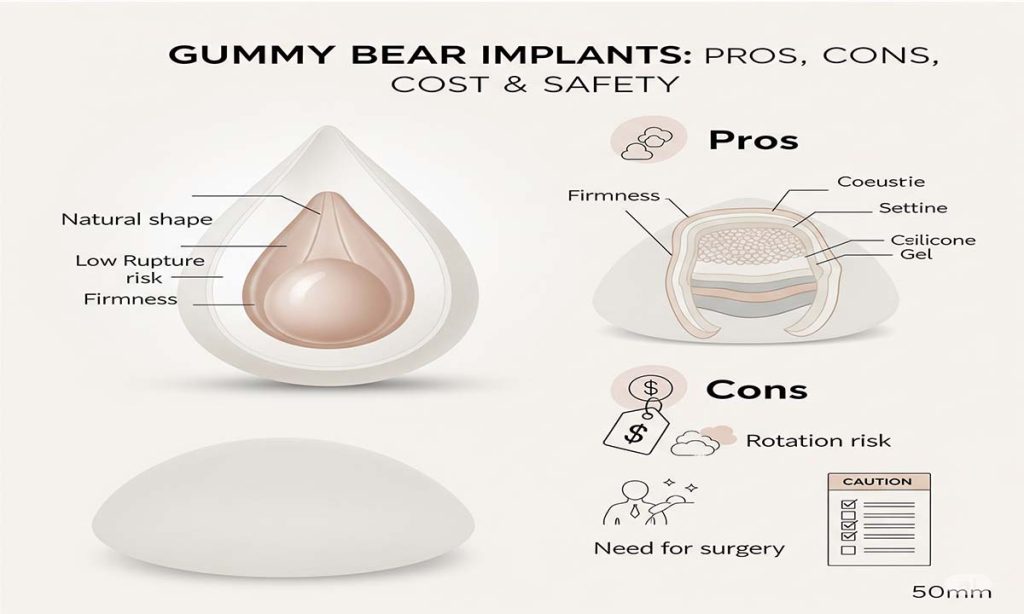![A surgeon holds a gummy bear breast implant (a cohesive silicone gel implant)]Gummy bear implants – also called gummy bear cohesive gel breast implants or gummi bear implants – are a type of silicone breast implant that maintain their shape even if their shell is broken. Unlike older silicone or saline implants, gummy bear implants use a very cohesive (thick) silicone gel that behaves more like a firm gel or a molded gelatin candy (hence the nickname). The result is a breast implant that retains an anatomical (teardrop) shape, providing a natural slope to the breast. This article explains what gummy bear breast implants are, how they differ from regular implants, their advantages and disadvantages, typical costs, safety considerations, and important precautions to take if you’re considering them.
Gummy bear implants are FDA-approved silicone implants whose gel is highly cross-linked so it stays together. In practice, this means a “form-stable” or teardrop-shaped implant that resists rippling and maintains upper-breast fullness better than traditional silicone or saline implants. Patients often prefer them for a more natural look and feel. However, this advanced design requires a slightly longer incision and comes at a higher price. Before deciding, it’s crucial to review all the pros and cons, costs, and safety precautions – from possible rotation issues to long-term care – to determine if gummy bear implants are right for you.

Table of Contents
What Are Gummy Bear Breast Implants?
Gummy bear breast implants are a subtype of silicone breast implant filled with a highly cohesive silicone gel. The gel’s consistency is firmer than traditional silicone: if the implant’s shell breaks, the gel holds together rather than leaking. They were FDA-approved in the early 2010s (e.g. 2012–2013) as the first “form-stable” or anatomical implants. Their molded shape – often a teardrop or anatomical form – mimics the natural contour of the breast. Because of this design, gummy bear implants offer a gradual slope (more fullness at the bottom) instead of the round, full-on-top look of round implants.
Cohesive gel implants have more chemical “crosslinks” in the silicone, which makes the gel denser and firmer. In short, gummy bear implants are silicone gel implants that retain their shape better over time. This shape stability is great for resisting sagging (bottoming-out) and rippling: the implant keeps its curve under gravity, preserving upper-breast fullness. Many patients report that gummy bear implants feel very natural to the touch and to the observer, in part because of their teardrop shape and firmer gel.
In practice, gummy bear implants often have a textured outer shell. The texturing helps the surrounding tissue grip the implant like Velcro, preventing it from rotating or shifting position. This is important because an anatomical (teardrop) implant has a defined “top” and “bottom”; if it were to rotate, the breast shape would change noticeably. The textured surface also appears to lower the risk of capsular contracture (hard scar tissue forming around the implant). In sum, gummy bear implants are highly cohesive, teardrop-shaped silicone implants – sometimes called form-stable implants – that aim to look and feel more natural than older implants, but with their own set of considerations.
Gummy Bear Implants vs. Saline and Silicone Implants
When comparing gummy bear implants to regular (traditional) implants, the key differences are in feel, shape retention, and cost. Traditional saline implants use a silicone shell filled with saltwater; they are usually the least expensive option and require a smaller incision (since the surgeon fills them after insertion). However, saline implants can feel less natural, may develop ripples, and would deflate visibly if they rupture. On the other hand, traditional silicone implants (the older gel style) have a softer, more natural feel than saline, but their softer gel means they can change shape over time, especially under gravity. These older silicone implants typically cost more than saline but less than gummy bear implants.
By comparison, gummy bear implants offer a compromise: they have a fairly natural feel thanks to the silicone gel, yet their very cohesive gel is firmer so that they reliably retain shape. This yields a consistently contoured breast. Gummy bear implants generally cost at the higher end – often comparable to or above traditional silicone – but offer the benefit of long-lasting shape. In practice, surgeons find that gummy bear implants cause less rippling and bottoming-out than saline or older silicone, providing a more “steady” outcome.
In bullet form, the trade-offs are:
- Saline implants: least expensive; filled with sterile saltwater. Pros: smaller incisions, easy detection of rupture (you will see deflation). Cons: may feel less natural, can ripple, typically not as soft or shapely as silicone options.
- Traditional silicone implants: moderately expensive; filled with a soft gel. Pros: generally natural look and feel, little rippling. Cons: softer gel can lose shape over time and won’t leak visibly if ruptured (called “silent rupture”). MRI scans are recommended to check silicone implants for silent rupture.
- Gummy bear implants: most expensive; filled with highly cohesive silicone gel. Pros: excellent shape retention (implant keeps anatomic contour), natural-feeling, lower rippling, more stable upper fullness. Cons: higher cost, firmer gel that may feel slightly firmer initially, and requiring a longer incision.
Overall, gummy bear implants are engineered for enhanced durability and aesthetics. They combine many advantages of both saline and silicone implants – no risk of fluid leakage (like silicone), and a stable shape (unlike saline) – at the expense of price and some surgical considerations.
Pros of Gummy Bear Breast Implants
Gummy bear implants have several advantages that often make them a popular choice among breast augmentation patients:
- Very Natural Look and Feel: Many patients report that gummy bear implants look and feel closer to natural breast tissue than other implants. Because of the teardrop shape and cohesive gel, the breasts have a gentle slope (less fullness at the top and more at the bottom) which mimics natural anatomy. In fact, as one specialist notes, “when touched they feel natural, to the user they feel natural, and to an outside observer they look natural”.
- Exceptional Shape Retention: The highly cross-linked silicone gel resists change in shape. This means less sagging or “bottoming out” over time. Studies show that gummy bear implants preserve upper-breast fullness far better than older silicone implants because the firm gel doesn’t flow downward under gravity. Patients can maintain their desired contour for longer.
- Lower Rupture and Rippling Risk: Data suggests gummy bear implants have lower rupture rates than traditional implants. Their dense gel also hides surface ripples and wrinkling that can be more visible with saline or softer silicone. The implant’s robustness means it’s less likely to tear or rupture, giving many patients confidence in longevity.
- Reduced Capsular Contracture (sometimes): Because gummy bear implants often have a textured surface, tissue tends to adhere to them. This texture can lower the chance of capsular contracture (hard, painful scar tissue). (Indeed, Healthline reports that textured anatomical implants have shown lower contracture rates.)
- Versatility: These implants come in a range of sizes and shapes (sometimes called anatomical or “shaped” implants). Surgeons can tailor the shape and projection more precisely to patient anatomy than with a one-shape-fits-all round implant. Women with tuberous or constricted breast bases often benefit from the anatomic form of gummy bear implants.
- Long-Lasting: Gummy bear implants are marketed as long-lasting. Many sources state they can last 10–25 years with proper care. In fact, one plastic surgeon notes that only about 20% of patients remove gummy bear implants within ten years, implying the rest keep them much longer. A typical 10–15 year lifespan is similar to silicone implants in general, but the firm gel may survive even beyond that in many cases.
In summary, the main advantages of gummy bear breast implants are their highly natural result and improved stability. They give a consistent, full shape at the bottom of the breast without excessive roundness up top. This can translate into very pleasing “before-and-after” outcomes when the patient’s goals are naturalness and minimal rippling. For patients willing to pay more upfront, gummy bear implants often mean fewer revision surgeries later on because the implants themselves are robust.
Cons and Risks of Gummy Bear Implants
No breast implant is without drawbacks or risks. It’s important to consider these cons of gummy bear breast implants alongside the pros:
- Higher Cost: Gummy bear implants are significantly more expensive than saline or standard silicone implants. The implants themselves often cost two to three times as much as traditional options, and the overall surgery (in an office or hospital) can run $6,000 to $12,000 or more. (For example, one clinic quotes a range of $6,000–$12,000 for the procedure, while another notes an average of $7,000–$9,000.) Be prepared to pay for surgeon fees, anesthesia, facility costs, and follow-up visits. Financing may be needed since cosmetic breast augmentation is almost never insurance-covered.
- Longer Incision and Scarring: Because the gummy bear implant’s cohesive gel is thicker, surgeons usually need a slightly longer incision to insert it. This can mean more visible scarring compared to the smaller incisions for saline implants. (The incision is often placed in the inframammary fold or around the areola to minimize visible marks.) Patients must follow meticulous wound care to reduce scar visibility.
- Risk of Rotation: Unlike round implants, anatomical (teardrop) gummy bear implants have a top and bottom. If a gummy bear implant rotates within the pocket, the breast shape can become distorted (e.g. one part may look too flat or too full). While the textured shell helps prevent movement, there is still an estimated ~1% chance of significant rotation with these implants. If rotation occurs, minor malposition may be corrected manually or may require revision surgery. Women with very loose breast tissue or significant sagging might be at higher risk of rotation.
- Firmness and Lowered Sensation: Gummy bear implants are firmer than soft silicone, especially right after surgery. Some women initially feel a bit more stiffness or pressure as the implants “settle” into place. Also, like any breast implant surgery, nipple and breast sensation may change (temporary or, rarely, permanent). According to Mayo Clinic, changes in nipple feeling are a known risk.
- Surgical Risks and Complications: General surgical risks apply, including bleeding, infection, blood clots, and poor wound healing. Other breast-specific complications include capsular contracture, implant malposition, and asymmetry. Although gummy bear implants have a lower contracture rate, the risk is not zero. (Healthline lists bleeding, infection, scarring, implant rupture, and anesthesia reactions among risks.) Postoperative pain and swelling are common in the first weeks, and full recovery can take several weeks. Patients should follow all post-op instructions (like avoiding heavy lifting) to minimize these risks.
- Rare Cancer Risk (BIA-ALCL): A serious, though rare, issue associated with textured implants is breast implant-associated anaplastic large cell lymphoma (BIA-ALCL). This is not breast cancer, but a lymphoma that can occur around breast implants. Health authorities (FDA and ACS) have identified a clear link between textured implants and BIA-ALCL. Since gummy bear implants are usually textured, they fall into this category. In fact, Allergan – a manufacturer of textured “gummy bear” style implants – voluntarily recalled all their Biocell textured implants in 2019 after data showed a higher ALCL risk. The ACS reports that of hundreds of BIA-ALCL cases worldwide, a large majority were linked to Allergan’s textured devices. The absolute risk of ALCL is still very low, but it is higher than with smooth implants. Patients with gummy bear implants should be aware of symptoms (persistent swelling, lumps, or pain) and have regular follow-ups.
- Non-Permanence: No breast implant is permanent. Over time, implants can rupture, shift, or develop complications. Mayo Clinic and ASPS note that many women will need revision surgery within 10–15 years. In fact, the FDA recommends routine imaging (MRIs or ultrasounds) every few years to check silicone implants for silent rupture. Gummy bear implants, despite their strength, still typically last about the same as standard silicone (around a decade) before a replacement might be considered. Thus, patients must plan for the possibility of future surgery if they want to maintain augmented breasts long-term.
In summary, the downside of gummy bear implants is mainly their cost and some surgical challenges. A longer incision and firmer implant can mean a longer recovery and possibly more noticeable scarring. There’s also the specialized risk of rotation with shaped implants. On the medical side, textured surfaces (though beneficial in some ways) come with the rare but real concern of BIA-ALCL. Patients should weigh these factors carefully and discuss all concerns with a board-certified plastic surgeon.
Cost of Gummy Bear Implants
The price of breast augmentation with gummy bear implants varies widely, but it is consistently higher than standard implants. Key factors include the surgeon’s experience, geographic location, facility fees, anesthesia, and of course the implants themselves. For estimation:
- Implant Cost: The gummy bear implant devices themselves can be quite expensive (often double the cost of a comparable smooth silicone implant). One provider estimates that a gummy bear augmentation procedure runs roughly $6,000–$12,000 overall. Many plastic surgeons cite an average in the high $6,000–$9,000 range for a complete surgery (bilateral implants, surgeon fee, etc.).
- Additional Fees: On top of the implants and surgeon’s fee, expect to pay for operating room or clinic facility fees, anesthesia, and post-operative garments. Mayo Clinic notes that women must be prepared to cover all costs, as insurance generally does not pay for cosmetic augmentation.
- Long-Term Costs: Remember to factor in potential future costs. If revision or removal is needed (after 10–15 years, or sooner if complications occur), those are extra procedures. Imaging for screening (MRIs or ultrasounds every few years) also adds long-term expense.
Compared to other implants, gummy bear implants push you toward the higher end of the cost spectrum. For context, a typical saline implant augmentation might cost $3,000–$5,000, and a traditional silicone augmentation might run $4,000–$7,000. Gummy bear augmentation commonly starts around $6K and can exceed $10K. The increased price reflects the implants’ technology and the surgeon’s skill. It’s wise to get a detailed quote ahead of time, and confirm what is included (implant cost, follow-ups, etc.). Some clinics offer financing or payment plans given the substantial out-of-pocket nature of this surgery.
Precautions and Aftercare
Before and after getting gummy bear implants, several precautions help ensure the best outcome:
- Choose an Experienced Surgeon: Because gummy bear implants are less forgiving (e.g. they can’t rotate if poorly placed without causing distortion), it’s critical to select a board-certified plastic surgeon with specific experience in anatomical implants. Check their before/after photos and reviews. Schedule a thorough consultation: your surgeon should discuss your anatomy, lifestyle (e.g. pregnancy plans, weight fluctuations), and goals. They will advise if a gummy bear implant is suitable for you. (For example, women who are pregnant, breastfeeding, or have uncontrolled medical issues are not good candidates. Also, those with significantly sagging breasts might benefit more from a breast lift or a round implant.)
- Pre-Surgery Health: Be in good general health. Smokers should quit weeks before and after surgery to promote healing. The Mayo Clinic advises patients to stabilize any chronic conditions, maintain a healthy weight, and get a baseline mammogram if age-appropriate. Avoid medications or supplements that thin the blood (like aspirin) as instructed. Disclose any allergies (e.g. to latex) to your surgeon.
- Know the Risks: Understand all potential complications (see above) and be vigilant post-op. Follow your surgeon’s post-operative protocol exactly: this may include wearing a support bra 24/7, avoiding heavy lifting or exercise for several weeks, and attending follow-up appointments. Recovery from gummy bear implant surgery typically spans several weeks. Initially, you may have swelling, bruising, and discomfort, but these improve steadily. Full recovery (when you see final results) may take 3–6 months as the implants settle and scars fade. Keep activity gentle at first: for example, limit lifting anything over 10 pounds and avoid raising arms above shoulder level for at least a couple of weeks.
- Follow Imaging Guidelines: After surgery, be aware of future monitoring. The FDA recommends that silicone implant patients get their first screening MRI 3 years after surgery, then every 2 years thereafter. Gummy bear implants, being silicone, fall under this guideline. These screenings look for silent ruptures (which are often leak-free in cohesive gel implants). Adhering to this schedule is a key precaution.
- Watch for Warning Signs: Keep a record of your implant’s brand and serial number. Know the signs of problems: uncommon swelling, lumps, severe pain, or asymmetry should prompt an immediate call to your surgeon. Specifically, since gummy bear implants are usually textured, be alert for symptoms of BIA-ALCL: persistent fluid accumulation around the implant, new breast swelling, or skin changes. This cancer is very rare, but it has a much higher incidence with textured implants. If concerned, your surgeon may perform a fine needle aspiration of any fluid or order imaging.
- Realistic Expectations: Gummy bear implants can improve shape and volume, but they won’t stop natural aging or weight changes from affecting breast appearance. They also do not correct sagging – if drooping is a main issue, discuss a breast lift instead. Remember that each person’s healing is different. It’s normal to have some stiffness or temporary asymmetry as implants heal in.
In short, take precautions seriously: prepare well, follow your surgeon’s instructions, and maintain a stable weight for at least 3–6 months before surgery. By being well-informed and cautious, you maximize the chance of a smooth surgery and satisfying result.
Gummy Bear Implants: Before and After Results
Patients often search for “gummy bear implants before and after” to gauge results. While individual outcomes vary, there are common trends to know. Before surgery, the breast may have less volume or a rounder shape (depending on existing anatomy). After surgery with gummy bear implants, most women see a naturally sloped breast that fills out the bottom half more than the top. Photographs from board-certified surgeons often show that gummy bear implants create a subtle enhancement – the breasts look fuller but not overly round or fake.
Since gummy bear implants settle slowly, your final look develops over weeks. Initially, there will be swelling that makes the breasts look higher and fuller than they will be long-term. Over the first 3–6 months, the implants will descend slightly and the tissue around them will soften. The textured surface will “take hold” as the capsule forms, locking the implant in place.
Key points about before/after:
- Comparison to Round Implants: In many “before vs. after” images, gummy bear implants show a more teardrop, natural shape. The upper breast has less sudden fullness (no “shelf” effect) and the lower pole maintains fullness.
- Symmetry and Contour: Because gummy implants are form-stable, breasts often appear very symmetrical and smooth. Rippling seen in thin-skinned patients with silicone or saline implants is usually absent with cohesive gel.
- Long-term Stability: Over years, gummy bear implants tend to preserve the post-operative shape better. “After” photos at 1 year vs. 5 years after augmentation often show that the implant shape and breast contour remain quite similar with gummy bear implants, whereas older styles might show more drop or rippling with time.
While this article cannot display photos, prospective patients should view accredited surgeons’ galleries of before-and-after photos. Search for terms like “gummy bear breast augmentation before and after” on reputable clinic websites. Remember that lighting, angle, and patient pose can vary, so focus on overall shape. Also, look specifically for cases similar to your situation (e.g. thin tissue, degree of sag, desired size) to set realistic expectations. Finally, discuss with your surgeon how size and shape choices will look on you; some offices use 3D imaging so you can preview “after” results.
FAQs
Q: What exactly are gummy bear breast implants?
A: Gummy bear implants are silicone gel breast implants that use a very cohesive (firm) gel. They keep their shape and come in a teardrop (anatomical) form. In other words, even if cut, the gel inside stays together. They’re also called “form-stable” implants. Think of them like a squishy gummy candy – the consistency is similar to a gummy bear – hence the name. These implants were FDA-approved in the 2010s and are designed to provide a natural slope to the breast, with stable fullness at the bottom.
Q: How do gummy bear implants differ from regular (traditional) implants?
A: The biggest difference is the gel. Traditional silicone implants have a softer, more fluid gel, whereas gummy bear implants have a firmer, highly cross-linked gel. As a result, gummy bear implants hold an anatomic shape better over time. Also, many gummy bear implants are textured on the outside, while many traditional round implants have smooth shells. Texturing helps gummy bear implants stay in place, reducing movement (but it also carries a rare cancer risk). In feel, gummy bear implants can feel a bit firmer initially, but many patients still find them very natural. In summary, gummy bear implants are often preferred when a very natural, tear-drop shape is desired; round or regular implants may move more freely but can be simpler in some cases.
Q: What are the main benefits (pros) of gummy bear breast implants?
A: The pros include their natural appearance and feel, strong shape retention, and longevity. They resist rippling and sagging better than saline or older silicone implants. Many patients say they look and feel virtually like natural breasts. Their cohesive gel means less chance of gel leaking if the shell tears. Also, because of their texture, they tend to have a lower rate of issues like capsular contracture. Lastly, they last a long time; many women don’t need a replacement for 10–15 years or more.
Q: What are the risks or disadvantages of gummy bear implants?
A: Drawbacks include higher cost (often much more expensive than saline or basic silicone implants), a longer surgical incision, and potential firmness. Because they are shaped, there is a small risk (~1%) that the implant could rotate, changing breast shape. Like all implants, they carry general surgical risks: infection, bleeding, anesthesia reactions, and scar tissue formation. Notably, since gummy bear implants are usually textured, there is a rare association with breast implant-associated ALCL (a type of lymphoma). Overall, they are not “risk-free,” and patients should discuss all concerns with their surgeon.
Q: How much do gummy bear implants cost?
A: Breast augmentation with gummy bear implants is typically $6,000–$12,000 or more in the U.S. This range covers both implants and surgery. For example, one plastic surgery resource cites a typical range of $6K–$12K for gummy bear implant procedures. One surgeon’s website lists $7,000–$9,000 on average. This is roughly double the cost of a saline augmentation. Always get an itemized quote: costs include the surgeon’s fee, hospital/facility fee, anesthesia, and the implants themselves. Keep in mind this price is generally not covered by insurance unless medically necessary.
Q: Are gummy bear implants safe?
A: In general, gummy bear implants are FDA-approved and widely used, and many surgeons consider them safe for augmentation. They have passed rigorous testing (FDA approved these implants in 2012) and in many ways are safer than earlier implants (lower rupture rates, less leakage). However, “safe” doesn’t mean zero risk. All breast implants carry risks of infection, pain, capsular contracture, or rupture. In addition, the textured nature of most gummy bear implants introduces the small risk of BIA-ALCL. Most experts recommend regular follow-up (including imaging) to catch any problems early. The consensus is that with an experienced surgeon and proper follow-up, gummy bear implants are as safe as other silicone implants, but patients must be informed about all potential complications.
Q: How long do gummy bear implants last?
A: Like all breast implants, gummy bear implants do not last a lifetime. Many plastic surgeons say a typical implant may need replacement in about 10 years. Some sources even suggest they can last 15–25 years for some patients, with only ~20% needing removal by 10 years. In practice, this varies: if you don’t have any complications and your body remains stable, your implants could remain for many years. But factors like pregnancy, weight changes, or capsular contracture can shorten the timeline. The key point is that patients should budget for possible future surgery after a decade or so.
Q: What precautions should I take before getting gummy bear implants?
A: Before surgery, ensure you are generally healthy: get medical clearance from your doctor if needed. Stop smoking weeks in advance, and avoid medications that thin blood. Discuss any autoimmune or chronic conditions with your surgeon. It’s ideal to be at a stable body weight, since significant weight gain or loss can change breast appearance. Also, get an up-to-date mammogram if recommended (often a baseline mammogram is done pre-op). This way, any future imaging can distinguish between implants and natural tissue. Finally, have realistic expectations: understand that you’ll have scars and a recovery period of several weeks.
Q: What are gummy bear implants recalled for?
A: In 2019, Allergan (a major implant maker) issued a worldwide recall of certain textured breast implants (including their gummy bear style) at the FDA’s request. The recall was not due to defects in mechanical performance, but because data showed these textured implants were linked to a higher risk of breast implant-associated ALCL. To date, most ALCL cases (about 84%) have been in women with Allergan’s textured implants. If you have gummy bear implants from a recall batch, your doctor will inform you, and you should monitor for symptoms like unusual swelling. The FDA has not recommended routine removal of implants in the absence of symptoms, but stay in contact with your physician for personalized advice.
Q: Can gummy bear implants cause problems with breastfeeding or pregnancy?
A: Most women can breastfeed after gummy bear augmentation, but it depends on the incision site and whether milk ducts were cut during surgery. The Mayo Clinic notes that implants might affect breastfeeding in some women. If you plan to breastfeed, discuss this with your surgeon pre-op. After surgery, know that pregnancy and significant weight changes can stretch the skin and alter breast shape, so it’s often recommended to finish having children before getting implants if possible. Hormonal changes from pregnancy won’t harm the implant itself, but they can change breast size significantly.
Q: How can I see gummy bear implants “before and after” outcomes?
A: Many plastic surgeons post galleries of before/after photos on their websites. Search for “gummy bear breast augmentation before after” or check surgeon profiles. These can give you an idea of the natural contour achievable. Keep in mind everyone’s body is different. Also remember that “after” photos at 6+ months post-op (when swelling has subsided) are most representative of the final result. If possible, schedule a consultation where a surgeon can show you their own patients’ photos.
Gummy bear implants have changed breast augmentation by offering a more natural, lasting shape, but they also come with higher cost and specific considerations. If you’re considering them, research thoroughly, talk to experienced surgeons, and weigh all the pros and cons listed above. Finally, share this article or leave a comment below if you found it helpful – we’d love to hear your thoughts or answer any questions!
Sources: Credible medical and surgical references including Healthline, Mayo Clinic, American Cancer Society, and board-certified plastic surgery practices.




